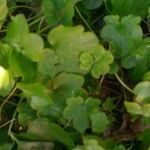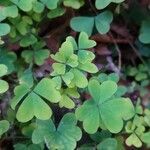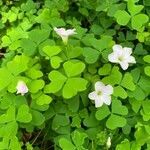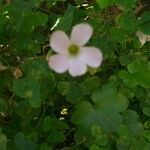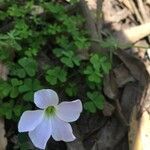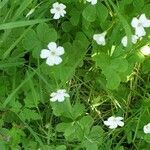Perennial herb with erect or somewhat spreading stems 5–30 cm long, branched, glabrous or very sparsely pubescent on younger parts; rhizome slender, 3–8 cm long; bulb ovoid, to c. 2 cm long, beaked, tunics pale brown, papery; bulbils formed on rhizome and in leaf-axils. Plants glabrous except for simple eglandular hairs on sepals, filaments and style. Stipules membranous, to c. 3 mm long, tapering into petiole. Leaves crowded at ends of branches, mostly 4–10 in pseudowhorls, palmately trifoliolate; petiole 1–7 cm long, glabrous; leaflets subsessile, mostly broadly obcordate, 5–15 mm long, 8–20 mm wide, bilobed (sinus to c. one-quarter leaflet length), green, often greyish below, glabrous, with a near-marginal irregular row of orange calli present, lobes oblong, apices rounded and 7–10 mm apart. Inflorescences axillary, 1-flowered; peduncles 2.5–12 cm long, longer than leaves, glabrous. Bracts situated c. half way along pedicel, linear-subulate, 2–2.8 mm long, calli prominent. Sepals oblong, 4–6 mm long, often with scattered, simple, eglandular hairs, with several converging light brown calli near apex. Petals obliquely subcuneate, 10–22 mm long, very pale lilac or pale pinkish-purple, greenish at base, glabrous. Stamens at 2 levels; filaments hairy. Ovary pubescent on the upper half. Styles pubescent below, glandular-pilose above. Capsules not developed in Australia.
Perennial, almost glabrous herb with thick fleshy contractile root; main bulb c. 2 cm long, subterranean; tunic brown, with scale nerves inconspicuous; secondary aerial bulbs or bulbils small, common in branch axils. Stems spreading to sub-erect, glabrous, with many flexuous, slender branches. Lvs 3-foliolate, glabrous. Petiole 2-7-(12) cm long; stipules forming a narrow to broad wing. Lamina of leaflets subequal, subsessile, 4-16 × 5-22 mm, mostly broadly obcordate, with ± divergent lobes, finely reticulate beneath, with a submarginal irregular row of orange calli; base ± narrow-cuneate, often slightly hairy. Fls solitary; peduncles 2.5-12 cm long, filiform. Bracts c. 1/2 way along pedicel, 2-2.8 mm long, linear-subulate; calli prominent. Sepals 4.5-5.5 mm long, ovate-oblong, often slightly hairy; calli 2, apical, prominent, orange. Petals 1.7-2.2 cm long, pale mauve, sometimes becoming almost white, glabrous; limb broad-obovate. Stamens in 2 whorls; filaments hairy, dilated towards base, < 4 mm long. Styles much > longer whorl of stamens, hairy except near apex. Capsule not seen.
Herbs perennial, caulescent, rhizomes present, <3–8 cm, slender, sometimes producing small tubers>, stolons absent, bulblets often present on rhizomes and in leaf axils. Aerial stems mostly 1–4 from base, mostly erect, 5–25 cm, herbaceous, glabrous. Leaves cauline, <usually in pseudowhorls of 4–8, sometimes opposite proximally>; stipules rudimentary; petiole 2–5(–7) cm; leaflets 3, green, sometimes purplish abaxially, obcordate, 6–10(–15) mm, lobed 1/4 length, <lobes apically convex>, surfaces glabrous, oxalate deposits absent. Inflorescences 1-flowered; peduncles 5–7 cm. Flowers: stamen/style arrangement not seen; sepal apices with 2 orange tubercles; petals white to pale pinkish purple with darker veins, 10–20 mm. Capsules not seen.
Caulescent geophyte, up to 0.3 m high. Bulbs ovoid, pale brown. Stem slender, branched. Leaves trifoliolate, leaflets obcordate. Flowers white or pale lilac with greenish tube. Flowering time Aug., Sept.
A herb. It keeps growing from year to year. It has small bulbs. The stems are upright with a crown of leaves and flowers. These are on single stalks with all stalks growing from a single point.
Caulescent geophyte with slender, branched stem, 10-30 cm. Leaves trifoliolate, leaflets obcordate. Flowers white or pale lilac with greenish tube, peduncle articulated.
